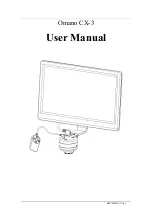
1
Thermo Scientific Orion AQUAfast AQ3010 Turbidity Meter User Guide
An accurate turbidity measurement depends on good measurement
techniques . Factors such as clean sample vials, positioning of vial in the
sample well, covering the vial with the light shield cover (if needed),
meter calibration, handling of meter and others have to be taken into
consideration . Refer to the
Vials – Handling, Cleaning and Care
and
Appendix 2 Guide to Good Measurement Technique
sections for more
information .
1 . Obtain a clean and dry sample vial . See
Figure 9
. Take care to
handle the sample vial by the top cap .
2 . Rinse the vial with approximately 10 mL of the sample water, capping
the vial with the black screw cap and gently inverting it several times .
Discard the used sample and repeat the rinsing procedure two times .
4 . Fill the rinsed vial with the remaining portion (approximately 10 mL)
of the grab sample up to the mark indicated in the vial . Cap the vial
with the supplied black screw cap .
5 . Wipe the vial with the soft, lint-free cloth supplied . Ensure that the
outside of the vial is dry, clean and free from smudges .
6 . Apply a thin film of silicone oil (supplied) on the sample vial . See
Figure 10
.
7 . Wipe the vial with a soft cloth to obtain an even distribution over
the entire vial surface . The purpose of oiling the vial is to fill small
scratches and to mask the imperfection in the glass . Do not apply
large quantity of oil as this may collect dirt and dust .
8 . The sample vial is now ready to be inserted into the sample well of
the meter for measurement .
Turbidity
Measurement
Procedure
Preparation of
Sample Vial
Figure 9
Sample Vial
Figure 10
Applying the Silicon Oil
















































